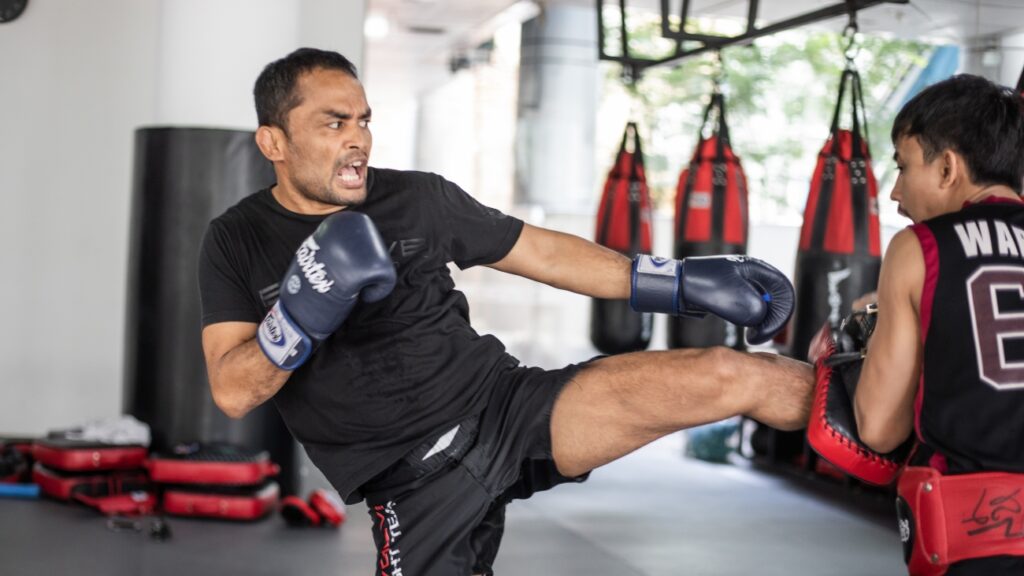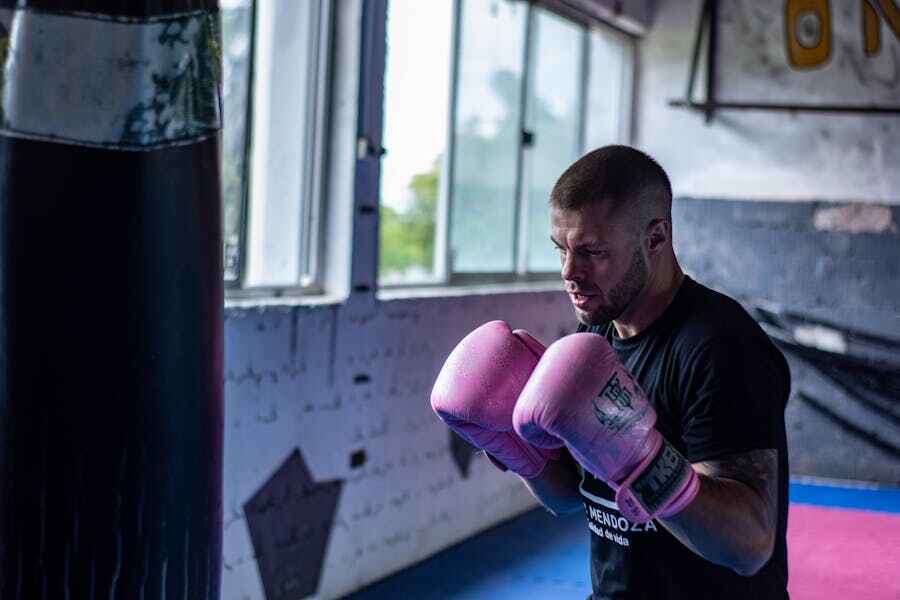Learning basic boxing skills for self-defense can take a few months to a year. Mastery takes several years of dedicated training.
Boxing is a powerful skill set for self-defense that can enhance a person’s confidence and physical conditioning. Mastering defensive maneuvers and offensive techniques is crucial for effectively using boxing for protection. Diligent practice and consistent training are essential for those keen on adopting boxing as a means of self-defense.
Beginners will start by grasping the fundamentals, including stance, footwork, and basic punches. Progress and proficiency depend on the individual’s dedication, the quality of instruction, and the intensity of their training regimen. As individuals invest time into regular practice, they begin to develop the muscle memory and reflexes necessary for self-defense scenarios. With the right mindset and commitment, learning the art of boxing for defense becomes an empowering journey.
Introduction To Boxing For Self-defense
Boxing, once seen as a competitive sport, now serves as a crucial self-defense technique. It equips individuals with the needed skills to protect themselves.
The Rise Of Boxing As A Popular Self-defense Technique
Boxing rose to be a popular self-defense technique due to its effectiveness. It makes use of basic punches that are easy to learn and remember. Below are some reasons for its rise:
- Boxing emphasizes speed and technique over brute force.
- Provides an effective way to handle multiple attackers.
- Improves physical fitness and reflexes, essential for self-defense.
Benefits Of Boxing In Real-life Defense Scenarios
Boxing provides many benefits in real-life defense scenarios. Let’s explore some of them:
| Benefit | Description |
|---|---|
| Physical Strength | Boxing improves your physical strength, making it easier to overpower an attacker. |
| Improves Reflexes | Boxing heightens your reflexes, helping you avoid sudden attacks. |
| Increases Confidence | Knowing you can defend yourself boosts your confidence in dangerous situations. |
| Enhances Endurance | Boxing training improves endurance which can be beneficial during prolonged confrontations. |
Learning Curve Aspects
Boxing for self-defense is a skill that demands time and effort. A key aspect of this learning journey is understanding the initial learning curve. Each individual’s pace and progress are guided by their physical fitness level and understanding of fundamental skills. The following sections discuss these aspects in detail.
Physical Fitness Requirements
Physical fitness plays a vital role in boxing. It helps you to stay agile and ward off attacks. Strength, stamina, and balance are vital elements of a boxer’s fitness level.
- Strength: Powerful punches are generated by a strong body. Regular strength training is necessary.
- Stamina: Boxing is exhaustive. High stamina enables you to fight or defend longer.
- Balance: A good balance lowers the chances of being knocked over. Balance training is essential.
Regular physical training, consistent practice, and a healthy diet aid in enhancing these aspects.
Fundamental Boxing Skills And Their Learning Timeframe
Mastering fundamental boxing skills is crucial for self-defense. These skills and their respective learning timeframes are described below:
| Skill | Learning Timeframe |
|---|---|
| Stance and footwork | 2 weeks to a month |
| Jabs and straight punches | 1 to 2 months |
| Combination punches | 3 to 6 months |
| Defense techniques | 6 months to a year |
Remember, becoming proficient in boxing takes patience. Consistent practice and proper guidance make the journey smoother.
Training Intensity And Regularity
Training Intensity and Regularity play crucial roles in mastering boxing for self-defense. The right balance can expedite skill acquisition and ensure practical readiness.
Designing An Optimal Training Schedule
Creating a well-structured training schedule is key. Beginners should aim for consistency.
Beginners:
- Start with two to three sessions per week.
- Focus on learning basic stances and movements.
- Gradually increase intensity.
Intermediate Learners:
- Three to four sessions are ideal.
- Introduce more complex combinations.
- Short bursts of high-intensity drills enhance agility.
Advanced Practitioners:
- Daily practice could become essential.
- Refine strategy and precision.
- Maintain peak physical condition.
Rest days are necessary for recovery and growth.
Balancing Technique, Sparring, And Fitness
Proper balance in training components is essential. Here’s a guide:
| Aspect | Beginner | Intermediate | Advanced |
|---|---|---|---|
| Technique | 60% | 50% | 40% |
| Sparring | 20% | 30% | 40% |
| Fitness | 20% | 20% | 20% |
Switch routines to prevent plateaus. Challenge the body and mind continuously.
Boxing Drills For Self-defense
Learning to defend yourself is a valuable skill. Boxing is a powerful tool for self-defense. It sharpens your reflexes and boosts your confidence. Let’s explore some boxing drills designed for self-defense.
Practical Drills To Enhance Reflexes
Quick reflexes can save you in dangerous situations. Here are some drills:
- Dodgeball: Use a tennis ball. Have a partner throw it at you gently. Work on dodging and weaving.
- Shadowboxing: Stand in front of a mirror. Throw punches at your reflection. Move your head and feet to avoid your strikes.
- Reaction bag: Hit a bag that moves unpredictably. This drill builds faster response times.
Focused Mitt Work For Real-world Application
For real-world self-defense, mitt work is essential. Try these exercises:
- Have your partner call out combinations. Strike the mitts as they are presented.
- Simulate real scenarios. Your partner can mimic common attacks. Practice your defense and counter-attack.
- Build endurance. Keep the mitt work fast-paced. Go for longer rounds to simulate a real encounter.
Mental Preparedness And Tactical Thinking
Boxing for self-defense requires not only physical prowess, but keen mental preparedness, and informed tactical thinking.
Mastering these aspects can fast-track your boxing training journey.
Developing The Fighter’s Mindset
A fighter’s mindset is vital in boxing. This mindset revolves around two principles: perseverance and strategy.
- Perseverance is about developing grit and endurance. Boxing isn’t easy. Training can be intense. Consistency and resilience will make you better.
- Strategy involves understanding and anticipating your opponents. Creating effective tactics to safeguard yourself and hinder your opponent’s moves.
Brain-enhancing activities can promote this mindset. Chess, puzzle games and meditation are few examples.
Situational Awareness And Decision-making Drills
Situational awareness is a crucial skill in boxing. It’s ability to read environmental cues and reacting efficiently.
It involves:
- Noticing your opponent’s habits and patterns.
- Positioning yourself strategically in the ring.
- Reacting promptly to their actions.
Decision-making drills can foster this skill. Such drills stimulate your brain to analyze situations quickly and strategize safely.
Verbally narrating sparring sessions is an effective drill. Train your brain to assess situations swiftly and act accordingly.
Evaluating Progress And Milestones
Evaluating Progress and Milestones plays a vital role in boxing training, particularly when learning for self-defence. This key process ensures that learners stay on track, meeting crucial goals while becoming confident and prepared.
Setting Tangible Goals In Boxing Training
Having clear goals drives boxing students forward. These aims give a sense of direction.
- Weekly Goals: Include mastering new moves or improving punch power and speed.
- Monthly Goals: Improve overall fitness level, master combinations, and enhance ring strategy understanding.
- Long-Term Goals: Target eventual competition participation or the achievement of a coveted belt ranking.
Acknowledgment of each met goal presents a boost to learner motivation and resolve.
Measures Of Self-defense Readiness
Track boxing readiness with these scientific measures: speed, power, reaction time, technique skill, and strategic understanding.
Speed is crucial. Timing speed bag hits and punch bag technologies helps calculate this metric.
Power and technique are vital, too. Aid evaluation by using a punch tracker. Remember, each boxer varies, so individual progress should guide expectations.
Reaction time often means the difference between success and failure. Drills like mitt work and dodge ball improve this aspect.
Strategic understanding is the final element. It’s best evaluated in sparring sessions.
Remember, progress is personal. Each milestone recognized adds to your readiness confidence.
Continued Growth And Adaptation
Boxing for self-defence is a journey, not a destination. The key to mastery is through continued growth and adaptation. Here, let’s delve into how aspiring boxers can advance in their skills and strategies.
Advancing Beyond Basic Boxing Skills
Boxers must never stop learning. After mastering the fundamental punches and defensive moves, it’s time to up the ante.
Speed, strength, and stamina become crucial. To improve these, here are some suggestions:
- High-intensity interval training (HIIT)
- Strength and conditioning exercises
- Long distance running
Also, practicing advanced techniques, like feinting and counterpunching, can uplift a boxer’s game.
Cross-training And Evolving Self-defense Strategies
Not all fights are equal. An attack can happen anywhere, in many forms. Hence, a boxer should be ready to adapt.
Cross-training comes in handy. It involves learning other martial arts or self-defence techniques. This can enhance a boxer’s adaptability in various scenarios. Here are a few popular cross-training options:
- Judo
- Wrestling
- Brazilian Jiu-Jitsu
Further, ongoing analysis and improvement of self-defence strategies is crucial. This can involve refining footwork, mastering timing, or improving power.

Credit: evolve-mma.com
Frequently Asked Questions For How Long To Learn Boxing For Self Defence
Can You Learn Boxing In 3 Months?
You can start learning boxing basics in 3 months, but mastery requires ongoing practice and dedication. Expect to learn fundamental stances, punches, and defensive moves within this time frame.
Is 30 Too Old To Start Boxing?
No, 30 is not too old to start boxing. Many people begin at this age and achieve success in fitness and competition.
How To Learn Boxing For Self-defence?
Start by finding a reputable boxing gym. Select an experienced coach for quality instructions. Attend regular classes and practice frequently. Learn basic boxing moves like jab, cross, hook. Master defensive techniques such as blocking and dodging. Always prioritize safety in every training session.
How Many Hours Does A Boxer Train Before A Fight?
Boxers typically spend 4-5 hours per day training for six days a week, 8-10 weeks before a fight. Rigorous physical, mental preparation and tactical planning are integral to their regimen.
Conclusion
Mastering boxing for self-defence isn’t a quick task. It takes commitment, discipline, and robust training. But remember, there’s no set timeline for everyone. Your progress hinges on personal effort and consistency. With unflinching dedication, you can confidently use boxing as a handy tool for self-defence.












































Leave a Reply